
The LONDON TRANSPORT D classThis page created 7th December 1999, by Ian SmithThe early Brush highbridge Daimlers: D35-D73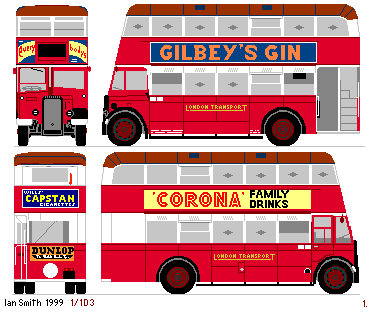 The Loughborough firm of Brush was the alternative supplier
of utility bodies to the Daimler chassis, and produced three batches.
The Loughborough firm of Brush was the alternative supplier
of utility bodies to the Daimler chassis, and produced three batches.
The first, D35 - D61, (1/1D3), although delivered in spring 1945, were to the full austerity specification, with restricted opening windows, wooden seating and limited displays. They had lobster-back rear domes, but looked rather smoother as the roof framing was inside the single skin rather than outside. The single opening windows were also set back into bay 4 rather than the normal bay 3. The front (only) display aperture was also deeper, although the bottom of it was masked off in red or black to accommodate standard utility size blinds. The ventilators also helped to distinguish these buses, the four on the roof being fitted at the edges, while each saloon window had a set of five diagonal vents above it. From the rear they were unmistakeable, with a single window in the emergency exit. Chiswick painted them into standard red and white (including the rear emergency exit), with black guards and red-oxide roof. They all went for service at Merton, during the spring of 1945. Once the war was over they lost their blackout trim and started to receive the peacetime quota of opening windows. The positioning of the single openers helped with this.
Second overhauls in the early fifties gave them all the overall red with cream band.
They continued at Merton, until withdrawal during late 1953 in most cases.
Most of them went for further service via North's of Leeds,
to Belfast Corporation (where they received new Harkness bodies before working until 1969);
to South Western omnibus in Ceylon; to Trimdon Motor Services near Sedgefield;
to Southend Corporation and to other independent bus companies.
The second batch: D62-73, 1/1D3/1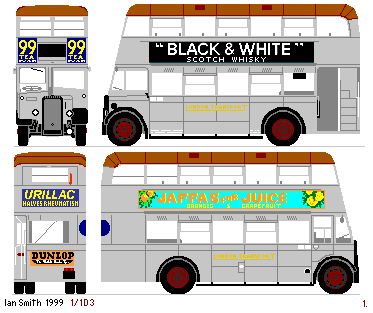 This batch of ten is small, but has a fascinating history of oddities.
Although built at the same time as the first batch,
their later authorisation allowed them to built to a relaxed specification.
These buses had a peacetime complement of opening windows when built,
plus upholstered seats.
This batch of ten is small, but has a fascinating history of oddities.
Although built at the same time as the first batch,
their later authorisation allowed them to built to a relaxed specification.
These buses had a peacetime complement of opening windows when built,
plus upholstered seats.
On the other hand, when they reached Chiswick in grey primer there was insufficient red paint available,
so four of them went into service in grey. They kept it, too, for nearly two years,
with local repaints and varnishing to keep it smart!
These were not official grey buses attending plants of wartime significance,
but were used on ordinary duties.
They finally received red and white shortly before their first overhauls
(when they received another repaint, of course!).
Post-London operation saw them go to Belfast, Ceylon and Southend for longer life with new bodies.
|
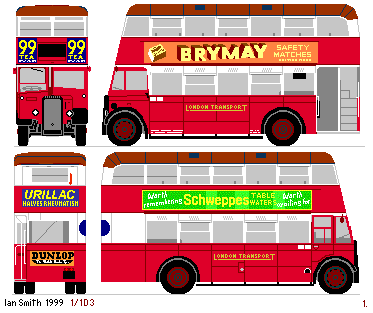 First overhauls produced upholstered seats and a repaint,
with the white saloon window surrounds again being deepened down to the moulding.
First overhauls produced upholstered seats and a repaint,
with the white saloon window surrounds again being deepened down to the moulding.
 bus histories
bus histories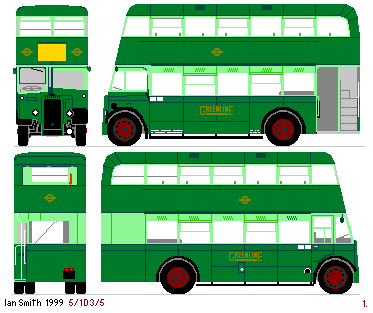 But for two of the ex-grey buses, and three others,
that first overhaul in December 1948 brought more drastic changes.
They were fitted with heaters and painted in a new two-tone green GreenLine livery.
They were recoded 5/1D3/5, and allocated to Romford to replace STLs
that were being withdrawn for conversion to SRTs.
Ostensibly they were for the London (Baker Street) to Whipsnade 726 service,
but were used turn and turn about with the Duple Daimlers on the 721 and 722.
But for two of the ex-grey buses, and three others,
that first overhaul in December 1948 brought more drastic changes.
They were fitted with heaters and painted in a new two-tone green GreenLine livery.
They were recoded 5/1D3/5, and allocated to Romford to replace STLs
that were being withdrawn for conversion to SRTs.
Ostensibly they were for the London (Baker Street) to Whipsnade 726 service,
but were used turn and turn about with the Duple Daimlers on the 721 and 722.
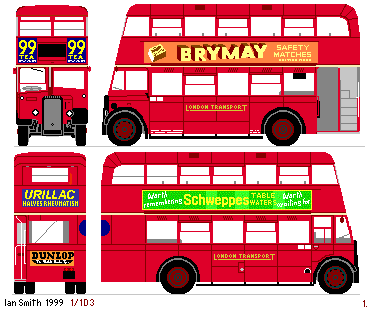 Meanwhile the red examples of the batch were also roaming.
Three were officially allocated to Sutton for various periods,
presumably as cover for overhauls or accident repairs at that all-Daimler garage.
All eventually received the overall red at second overhaul,
and some of them survived to the end of Daimler operation at Merton in January 1954.
Meanwhile the red examples of the batch were also roaming.
Three were officially allocated to Sutton for various periods,
presumably as cover for overhauls or accident repairs at that all-Daimler garage.
All eventually received the overall red at second overhaul,
and some of them survived to the end of Daimler operation at Merton in January 1954.
 Ian's Bus Stop
Ian's Bus Stop Daimler index
Daimler index early Duples
early Duples